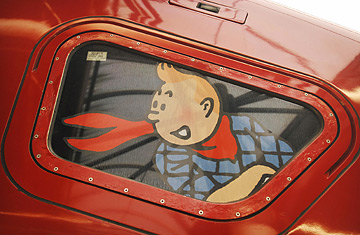
A sticker of Tintin decorates a window of a high-speed Thalys train, in Brussels.
The films, for Spielberg's DreamWorks studio, will be produced in full digital 3-D using performance-capture technology, which takes points of reference from real-life subjects and transfers them to animated characters on the screen. Spielberg and Jackson will each direct at least one movie; there is no word yet on who will helm the third.
The timing could not have been more apt: Tintin's creator, Hergé, was born one hundred years ago on Tuesday. Many credit Hergé, whose real name was Georges Remi, with inventing much of the visual grammar that defines modern comics. His books involve masterly plots and a depth of humor, artistry, detail and characterization. His iconic comic strip hero travelled the world fighting crime and ventured to the moon a full decade before Neil Armstrong.
Tintin's arrival in Tinseltown is perhaps inevitable: his popularity as a children's literary hero rivals that of other recent transitions from the page to the screen, including Harry Potter, Spider-Man and The Lord of the Rings.
Spielberg is a noted fan and the movie plans come a quarter of a century after he first bought an option to film the character. Just before his death, at age 75 in 1983, Hergé was poised to clinch a production deal, but after reading in the contract that Spielberg might not direct the films himself, he refused to sign.
The new film plans are just part of this year's centenary celebrations. They include two Tintin musicals, a Tintin museum, an exhibition at the Pompidou center in Paris, as well other events in Stockholm, Barcelona and Lausanne. In addition there will be commemorative stamps (Belgium, France and Switzerland), coins and chocolates, among other merchandise, and learned academic seminars.
The adventures of Tintin, a young reporter, were chronicled in 23 books published between 1929 and 1976, which have collectively sold more than 200 million copies worldwide. This was hardly anticipated when a crudely drawn Tintin made his first appearance on January 10, 1929 in a comic supplement to a Brussels newspaper in a story entitled "Tintin in the Land of the Soviets."
But he was an immediate hit with the Belgian public, and was quickly dispatched to other hotspots of the time, from Al Capone's Chicago to Japanese-occupied China. Tintin is ostensibly a reporter, but he never appears to have deadlines or editors; he is actually seen filing a story in only frame over the entire oeuvre.
Like Jules Verne, Hergé rarely left his desk, but he made Tintin a world traveler, meeting cultures that his creator encountered only in books and magazines. Over the course of the books (Hergé would call them albums), Tintin acquired a panoply of colorful companions: his faithful dog Snowy; his hard-drinking, foul-mouthed friend Captain Haddock; egghead Professor Calculus; bumbling detectives the Thompson Twins; and overbearing opera diva Bianca Castafiore.
"There is something about Tintin that defies time, language and culture," says Michael Farr, author of Tintin: The Complete Companion. "The child will be gripped by the excitement, the comedy and even the farce. The adult will additionally find political satire and parody, puns and prescience."
The early books included coarse stereotypes, and Hergé has been accused of racism in Tintin in Congo (although this book is particularly popular in Africa). Hergé was later arrested for being a wartime collaborator as he continued to draw cartoons for newspapers that were controlled by the Nazi occupiers during World War II. He spent a night in prison, but his file was eventually closed without legal action. But rumors and insinuations followed him for the rest of his life, and he had frequent bouts of depression.
In fact, Hergé was contrite about Tintin in Congo, which was never published in English during his lifetime. And in the 1930s he was injecting anti-Nazi storylines into his work. In later books, Tintin is found fighting both communists and capitalists, and by the 1970s he had replaced his cloth cap and plus fours with blue jeans and yoga.
Hergé's favorite story was the 1960 Tintin in Tibet, which tells of Tintin's search for a Chinese boy, Chang (based on one of Hergé's closest friends), whose plane crashes in the Himalayas. Last year, the Dalai Lama himself awarded a "Truth of Light" award to the Hergé Foundation, which runs the late author's estate, as a gesture of thanks to "significant contributions to the public understanding of Tibet" through the book, written a year after the Dalai Lama was driven into exile by the Chinese government.
Hergé's overall influence was vast. He mastered a style of drawing called ligne claire or clear line: a clean, pared-down style of simple, precise lines. His work involved stylized detail throughout, with no shading and sheer blocks of color. Hergé's impact went beyond the world of comic strips, influencing the work of artists like Roy Lichtenstein and Andy Warhol. His storytelling was also pioneering. Tom McCarthy, author of last year's Tintin and the Secret of Literature, says the books create "a huge social tableau... managed with all the subtlety normally attributed to Jane Austen and Henry James."
One hundred years after Hergé's birth, Tintin is finally getting his due recognition. And as he prepares for his Hollywood debut, Tintin can look forward to a new episode in his extraordinary adventures.
